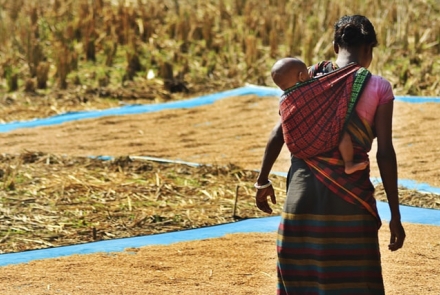
Photo by manzur alam on Unsplash
Gender in post COVID-19 development policy
As we begin to comprehend the ramifications of COVID-19 pandemic, it is fair to ask if the pandemic is gendered or not, Kuntala Lahiri-Dutt writes
What does it mean for the COVID-19 crisis to be ‘gendered’? Clearly, this is not implying a sex-selectiveness in the manner in which the disease attacks, although there is evidence that slightly a greater number of men have been affected so far.
The pandemic is gendered not in who gets sick. Gender becomes important when policymakers consider questions of why gender plays a crucial role in determining who does what in a pandemic, or how the effects of the coping measures are gender-differentiated. It comes into the equation when governments consider how gender relations alter due to the unprecedented consequences unleashed by the disease, and how the steps adopted to tackle the disease affect women and men differently.
These questions have deep significance for policymakers, health, and development professionals who need to be aware of the gender-specific impacts – both unintended and foreseen – of each of their interventions to control the pandemic and rebuild afterwards. In other words, all policies pertaining to COVID-19 must consider gender.
Let’s put on a feminist lens to see some facts related to the COVID-19 pandemic, and where development policymakers need to focus their attention in the future.
Evidence is accumulating to show the pandemic control measures have had significantly more negative consequences on women than men. A report in The Lancet argues that the gender impacts of COVID-19 are not to be found in the numbers of affected or dead, but in the gender-differentiated fallout of the control measures, the economic and social changes during and after the pandemic, and the policies to revive the economy after the pandemic is over.
The United Nations Working Group on discrimination against women and girls have made a statement to note that responses must not ignore women’s needs and interests. Reports from more affluent nations has emerged to show an alarming surge in domestic violence as people lose their jobs and are forced to stay at home.
The development sector cannot ignore any of the gender implications and consider the possibilities that could be opened up through their responses to COVID-19.
The world is still characterised by remarkable gender inequalities, and care is still largely a feminine domain. Women are at the forefront of fighting the pandemic because they still comprise the backbone of hospitals and nursing homes where care for COVID-19 patients is being carried out.
Women are also overrepresented in the more affected sectors such as the service sector of the economy, making them more vulnerable to job losses. The International Labour Organization has estimated that 59 per cent of employed women work in the services sector around the world, compared to 45 per cent of men. Women also have less access to social protection, and consequently will suffer when support does not directly target them.
Women remain vulnerable in public spaces including the workplace and are discriminated against in the spite of significant gains. In less affluent countries, women are over-represented amongst the poor, carry a disproportional burden of unpaid labour in the economy, and contribute enormous quantities of labour to the informal economy. For example, in India, 97 per cent of women’s labour is concentrated in low-paid jobs in the including agriculture.
The true extent of the spread of the disease in less affluent countries may never be known due to poor record-keeping practices, and debates about the robustness and appropriateness of responses will continue for many years as the full impacts unfold.
One thing is sure, however. The impacts of any policies, measures and actions, if ungendered, will be deep. In developing countries, the emergency is not caused by just the one virus, for a stagnant, unproductive and decaying rural economy, social distancing requirements combined with remarkable gender inequalities have been crushing women’s lives.
With poor or non-existent infrastructure, no safe and adequate water supply or proper sanitation, and social ills such as continued caste-and-gender-based discrimination, the impact of the pandemic will be felt intensely by the rural sector, turning the pandemic from a health crisis into a full-scale humanitarian disaster.
If the poor has become the collateral damage in this pandemic, it is the lives of poor women that have been forever and profoundly altered. Unprotected female workers are at a greater risk than most men.
Most urban households, for example, run on the cheap labour and the domestic help of migrant women labourers. Social distancing brought out the deeply embedded sexism and casteism as employers shunned these women. In cities, the incidence of domestic violence has increased remarkably.
So far, the COVID-19 response has lacked a gender approach except in some countries such as Australia where the government has taken steps to curb the spike in domestic violence. In India, where 2.1 billion people still lack the basic right to access to clean and safe drinking water and where women are tasked with fetching household water, one can only imagine the implications of additional restrictions.
Women’s close links to water – for household as well as for productive purposes are well-known. COVID-19 responses need to pay attention to these gender-specific health risks to women, and women’s care-giving roles in addition to recognising women’s contributions to the economy.
For development policymakers and planners operating in the post-COVID-19 world, they must not simply pay closer attention to women in the informal economy, but take on a stronger and more holistic focus on health, work, and gender, and infrastructure.
Any policy, any action, any project will need to have a clear gender perspective to make it truly fair and just. We cannot anymore presume that development benefits will trickle down to women and instead, should see this as an opportunity to widen and deepen efforts to integrate gender into these crucial decisions. So far, responses have lacked this crucial understanding. Perhaps it is not too late to put on that not-so-elusive feminist lens?
Updated: 27 July 2024/Responsible Officer: Crawford Engagement/Page Contact: CAP Web Team













